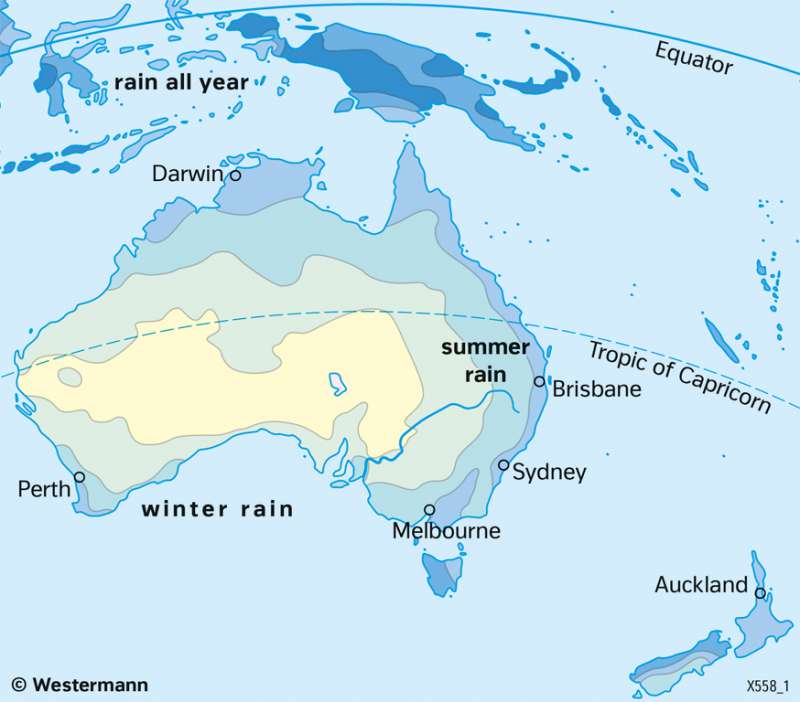Australia and New Zealand - Annual precipitation
Economy and land use
978-3-14-100890-6 | Page 164 | Ill. 2

Overview
While parts of Indonesia experience annual precipitation of over 3000 millimetres as a long-term average, it is mostly much lower in Australia. The highest values are reached along the east, north and south coasts. On average, between 500 and 1000 millimetres of annual precipitation fall here, and even over 2000 millimetres in the backwater of the Australian Highlands. The interior and the west of Australia, on the other hand, partly reach values of less than 250 millimetres and are therefore characterised by a pronounced dryness.
In New Zealand and on the Pacific islands, windward-leeward effects are particularly noticeable on mountains when the wind directions are dominant (trade winds or westerly winds), but these are not clearly visible on the map because of the scale.
Monsoon and trade wind currents
In the southern summer, the subtropical high-pressure belt mainly influences southern Australia. Descending air masses ensure stable high-pressure weather conditions with low cloud cover and high solar radiation. Only in the southeast can precipitation fall due to the absorption of water over the ocean.
In the summer months, the north of Australia is mainly under the influence of the southeast trade wind. Occasional heat lows cause local heat storms there. Between December and February, the Intertropical Convergence Zone (ITCZ) lies between northern Australia and Indonesia. This causes the trade winds to blow across the equator to the southern hemisphere, where they are redirected to northwest winds. They bring real monsoon rains to the northernmost parts of Australia. On the east coast, onshore winds in the area of influence of the trade winds cause summer rains ("quasi-monsoon").
In the southern winter, the subtropical high-pressure belt shifts northwards. Northern Australia is now completely within its sphere of influence. Precipitation therefore falls at most through windward effects along the north-east coast. The interior of the continent is characterised by sunny, dry weather. Large parts of South Australia come are impacted by the extratropical westerly wind zone on the southern side of the high-pressure belt. Cold fronts cause stormy weather and precipitation even into the interior of Australia. South of Perth and around Melbourne, characteristic winter rainfall areas have formed for this reason.
Monsoon and trade wind currents
In the southern summer, the subtropical high-pressure belt mainly influences southern Australia. Descending air masses ensure stable high-pressure weather conditions with low cloud cover and high solar radiation. Only in the southeast can precipitation fall due to the absorption of water over the ocean.
In the summer months, the north of Australia is mainly under the influence of the southeast trade wind. Occasional heat lows cause local heat storms there. Between December and February, the Intertropical Convergence Zone (ITCZ) lies between northern Australia and Indonesia. This causes the trade winds to blow across the equator to the southern hemisphere, where they are redirected to northwest winds. They bring real monsoon rains to the northernmost parts of Australia. On the east coast, onshore winds in the area of influence of the trade winds cause summer rains ("quasi-monsoon").
In the southern winter, the subtropical high-pressure belt shifts northwards. Northern Australia is now completely within its sphere of influence. Precipitation therefore falls at most through windward effects along the north-east coast. The interior of the continent is characterised by sunny, dry weather. Large parts of South Australia come are impacted by the extratropical westerly wind zone on the southern side of the high-pressure belt. Cold fronts cause stormy weather and precipitation even into the interior of Australia. South of Perth and around Melbourne, characteristic winter rainfall areas have formed for this reason.




